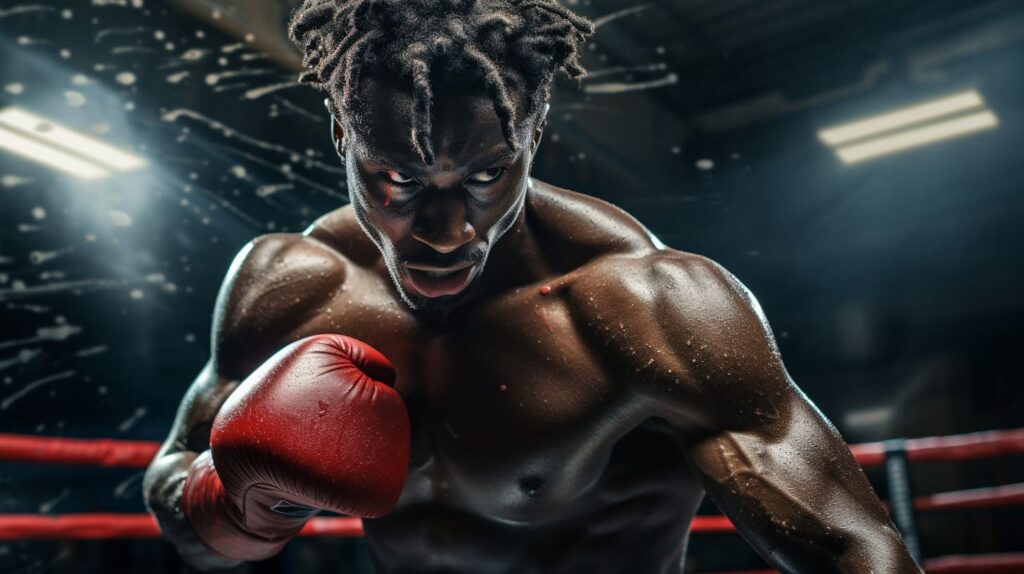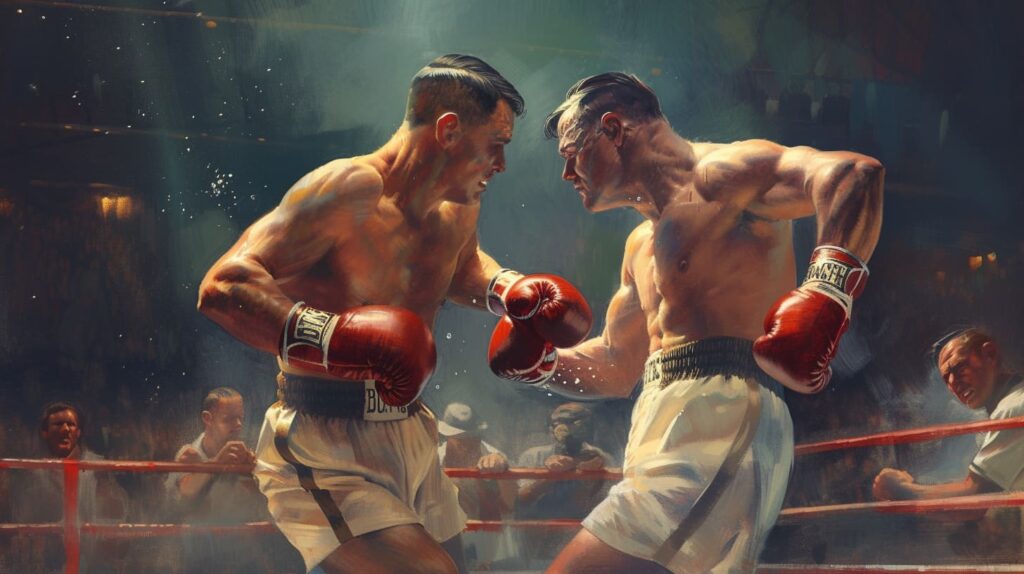When you step into the ring, it’s not just about throwing punches and blocking hits. Your boxing style is like your signature—unique and telling, crafting the narrative of each bout you enter. It’s about stance, movement, and the punching technique. Now, what do these elements entail?
Stance How you stand in the ring isn’t just about comfort; it’s a strategic decision. Your stance dictates your reach, defense capabilities, and even your punching power. Are you an orthodox fighter, leading with your left and keeping the right back as your power hand, or are you a southpaw, mirroring this stance with a right-handed lead? Each stance plays to different strengths and prepares you for the dance of boxing.
Movement The way you move can be likened to a game of chess. Each step, pivot, and shuffle positions you for success or puts you in the line of fire. Good footwork helps you maintain balance, control the distance between you and your rival, and set up your attacks. It’s not just about foot speed; it’s about foot intelligence.
Punching Technique Your fists are the tools of the trade, but it’s technique that sharpens them. A well-executed punch combines speed, accuracy, and power, rooted in rigorous training. From the straight power of a cross to the swift snap of a jab, your punching technique can define you as a fighter.
Recognizing and perfecting these fundamental aspects helps you to develop a style that complements your natural abilities, aiding you in your quest to outmaneuver and outfight your opponent inside the ropes.
Classic Boxing Styles Overview
Let’s dive into the diverse world of boxing, where styles are as varied as the fighters themselves. The way a boxer presents in the ring is a blend of art and athleticism, honed through years of sweat and strategy. Here’s a glimpse at some classic boxing styles, each with its distinctive rhythm and tactical approach.
The Slugger (Brawler)

For those who love the thrill of power punches and non-stop action, meet the slugger. This fighter is the embodiment of resilience and raw power. Defined by their willingness to take a punch to deliver a crushing blow, sluggers are reminiscent of warriors who thrive on the drama of a fight. They’re known less for finesse and more for their ability to deliver one-punch knockouts that leave audiences gasping.
Characteristics:
- Powerful Punches: They often possess a knockout ratio that makes statisticians sit up and take note.
- Iron Chin: A slugger can absorb punches that would fell lesser mortals, testament to their grit.
- Minimal Footwork: They don’t dance around – slugging is a straight-line affair, with a focus on offensive strength, not evasion.
Famous Examples:
- George Foreman: With his imposing structure, he’d hammer his opponents into submission.
- Rocky Marciano: Unbeaten, unbowing, a slugger who defines the essence of the term with every battle he won.
Sluggers remind us that in the world of boxing, brute strength coupled with the will to use it can be a game-changing tactic.
The Swarmer (In-fighter)

Contrary to the calculated dance of other styles, the swarmer is about relentless wrath. This fighter crashes into their opponent’s space, unleashing a torrent of punches from every angle imaginable. With a work rate that exhausts and overwhelms, a swarmer is a force of nature in the ring, a veritable storm of fists and fury.
Characteristics:
- High Volume of Punches: They often outperform the average by throwing an avalanche of punches that can eclipse the typical 40-50 per round.
- Closeness: Swarmers prefer to fight at a phone booth distance, smothering their opponents.
- Stamina & Speed: They possess the engine of a marathon runner with the burst speed of a sprinter.
Famous Examples:
- Joe Frazier: He brought a relentless fury to the ring, breaking wills and records equally.
- Mike Tyson: Known as “Iron Mike”, his approach was simple – swarm, strike, and stand victorious.
Swarmer fighters are a testament to the adage that pressure creates diamonds, or in their case, victories won through sheer volume and ferocity.
These styles paint a picture of diversity within the world of punching arts. Now, let’s get prepared to explore more styles that have shaped the boxing landscape.
The Role of Physical Attributes and Personality in Boxing Styles
Stepping beyond the punch’s impact and the swift dodge, let’s consider the physical and psychological fibers that weave the fabric of a boxer’s style. How does one’s reach, resilience, or reflexes affect their approach in the ring? And what about the mindset and moxie that separate contenders from the rest? This part of the guide delves into these aspects, revealing how they mold a boxer’s approach to the craft.
Understanding the Physical Essentials

Boxers come in all shapes and sizes, each with physical advantages that can be leveraged in the ring. The obvious traits, such as reach and height, play critical roles in how a fighter engages with their opponent. Similarly, hand speed and the natural strength of a boxer can dictate their approach to offense and defense.
- Reach: A longer reach naturally benefits out-boxers who capitalize on distance to dictate the fight’s tempo.
- Height: Height can be a double-edged sword—advantageous for maintaining range but possibly a hindrance when fighting in close quarters.
- Hand Speed: Vital for swarmers and counter-punchers who rely on quick exchanges and nimble strikes.
- Strength: An underlying factor for slugging power; it’s not just about muscle but how you harness it with technique.
The Mind Behind the Gloves

Boxing is not just physical; it’s a mental chess game. The interplay between a boxer’s personality and fight style can be as influential as their physical capabilities. A cerebral boxer might choose a technical style that requires patience and precision, while a more aggressive personality could lead someone to embrace a swarmer’s relentless assault.
- Risk Tolerance: Sluggers often have a high threshold for risk, willing to take a hit to land a decisive one.
- Strategic Thinking: Counter-punchers rely on outsmarting their adversaries, often personifying the archetype of the ‘thinking fighter.’
- Adaptability: A key trait for out-boxers, the ability to adjust strategies on the fly can be a crucial advantage.
- Aggression Level: More aggressive boxers may gravitate towards swarming, using intense offense as their best defense.
Blending the physical with the psychological, we begin to see how each boxer shapes a style that’s as complex and nuanced as their personality. In the next section, we’ll look into how training can sharpen these natural propensities into a boxer’s most formidable weapons.
Moving on in our exploration, training habits do more than build muscle—they chisel the boxer’s approach into something that’s fluid in motion yet solid in principle. Let’s lace up and dive into the regimen that shapes a boxer’s style.
Training for Classic Boxing Styles

Boxers don’t just stumble upon their style; it’s carved out of the bedrock of routine, practice, and sometimes, necessity. Each style, with its particular demands, has a curated set of drills to maximize a fighter’s potential within that discipline.
Sharpening the Slugger
Sluggers work on amplifying their knock-out blow and durability. Their training typically revolves around power and resistance.
- Power Drills: Plyometrics and heavy bag workouts are vital, focusing on explosive strength.
- Chin Conditioning: While not literally training to take a hit, sluggers do train to toughen up through rigorous fitness routines.
- Stance and Balance: Fundamental to ensuring each punch carries maximum weight without compromising on stability.
Crafting the Swarmer
The swarmer lives by stamina and speed. Their training is a crucible of endurance and agility.
- Cardiovascular Workouts: To forge the engine of a marathon runner, swarmers prioritize high-intensity interval training (HIIT).
- Close-Range Combat: Practicing combinations at close range to mirror in-fight scenarios.
- Agility Drills: Footwork is pivotal, with ladder drills and shadow boxing playing key roles in their regimen.
Training molds the boxer as much as natural ability. In the following sections, we delve deeper into how specific exercises build on these strengths to prepare each boxer for the unique challenges they’ll face when the bell rings.
Perfecting the Out-boxer
In the world of the out-boxer, precision is king. These fighters train to exploit their reach, utilizing their jab as a key weapon while staying light on their toes.
- Jab Mastery: Constant drills to perfect the jab, making it quick, accurate, and powerful.
- Distance Control Exercises: Techniques to control the space between themselves and their opponents, including lots of in-and-out movement drills.
- Cardio and Endurance: Focused on maintaining the stamina to dance around opponents all night long.
Out-boxers like Floyd Mayweather Jr. and Vasyl Lomachenko exhibit these traits with such finesse that they appear almost untouchable in the ring.
The Counter-puncher’s Regimen
Counter-punchers, with their reactive precision, favor a balanced blend of offense and defense. Their training sharpens their ability to exploit any opening with precise timing.
- Defensive Drills: Emphasis on slipping, rolling, and blocking to avoid punches while staying in a position to strike back.
- Timing Exercises: Countless hours practicing the art of timing to land counter-punches just as the opponent exposes themselves.
- Strategic Sparring: Sparring sessions focused on reading opponents and finding the perfect moment to unleash countermeasures.
A counter-puncher like Juan Manuel Marquez showcases the effectiveness of this style—waiting for the perfect moment to land a fight-changing punch.
Conclusion
As we pull our gloves off and step out of the ring, let’s remember that the soul of boxing is woven deeply into these styles. It’s a dance of discipline and determination, where every fighter finds harmony between their natural abilities and the style they’ve polished through sweat, grit, and relentless training.
For those of you wrapping your hands and stepping into the square circle, or even those watching from ringside, these classic boxing styles are more than just tactics—they’re a reflection of the boxer’s very spirit. Embrace the style that speaks to you, train with purpose, and may your fighting heart always be full. Whether you decide to weave and jab as an out-boxer or stand and deliver as a slugger, your style is your boxing signature—make it formidable, make it yours.
Additional Resources
Let’s lace up our gloves and step beyond the ring. As we’ve navigated the classic boxing styles, you might be itching to learn even more, or maybe you’re prepping to start your own boxing journey. Good news: there’s a wealth of knowledge out there just waiting to be tapped. Here’s a selection of top-notch resources to help you dig deeper into the sweet science of boxing.
- BoxRec
- If you’re a stats person, BoxRec is the place to be. It’s the ultimate database for fighter records, historical matches, and rankings to study the greats of the past and present.
- Head over to BoxRec
- Title Boxing
- Title Boxing offers a great assortment of training videos and articles. Whether you’re looking to improve your punching power or footwork, they’ve got you covered.
- Check out Title Boxing
- The Modern Martial Artist
- For visual learners, The Modern Martial Artist YouTube channel breaks down the techniques and fights of top boxers in an engaging and informative way.
- Watch The Modern Martial Artist
- “Championship Fighting” by Jack Dempsey
- Dive into this classic book written by one of boxing’s legends, Jack Dempsey. It’s a timeless resource that provides insight into the techniques that made him a champion.
- Get it on Amazon
Whether you’re just a fan of the sport or a fighter honing your craft, these resources will provide you with a wealth of knowledge to better understand the nuances of boxing. Keep studying, keep practicing, and who knows? Maybe one day, we’ll be talking about your classic style in the world of boxing.

